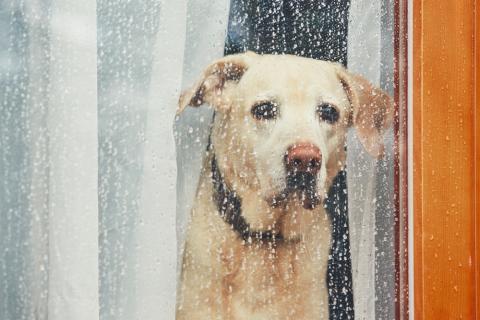
Every good dog owner knows the importance of both physical exercise and mental stimulation for our canine companions. Frequent walks and jaunts to the dog park become part of the routine in order to keep our furry friends healthy and happy (and let’s be honest—it helps our health factor, too).
So what’s a conscientious pooch parent to do when the days are full of rain or snow? If you’re fortunate enough to have a Labrador, retriever, or some other dog that enjoys playing in the wet stuff, then you should try to periodically suit up and take them out to enjoy themselves—even if it means you’re a little uncomfortable for a few minutes. (Don’t forget to suit up your sidekick too, if it’s cold/wet enough to be necessary.) But if you’re like me, with a dog who absolutely refuses to leave the comfort of the house if it’s raining, you’ll find yourself looking for indoor-friendly ways to get your canine off the couch and moving around.
With a little creativity, you can find all kinds of activities to engage your dog when you both have a bit of cabin fever. You can use things around the house to provide your dog mental challenges and if you have enough room inside you can play games to get them running around a bit, too.
1. Scent Scavenger Hunt
Mental stimulation can tire out a dog just as efficiently as physical activity. While it’s really best to get a combination of both, this game can be a good way to get your dog’s brain juices flowing if you live in a small space and just can’t manage anything physical.
Look around the house for empty plastic containers: old food containers are a good source (the flimsy plastic tubs you get in the deli, for example), as are those plastic cases candy and gum come in these days. You can also use small cardboard boxes, if they’re pretty sturdy, although you’ll need to replace them more often as they can’t be cleaned. Ideally, the plastic should be thin enough you can poke a few holes in it, but you can work around this by leaving the lid off instead if you need to. You’ll also need a few treats with a smell that appeals to your pup.
Next, you’ll want to teach your dog the game. You might have to spend several days on each step in the list, depending on your dog’s individuality. Also, based on how much nosing experience your dog has, you can start anywhere on this list. (If you’ve done scent work with your dog before, she’ll probably catch on quick.)
- Start by hiding a few treats in places around the house where the dog can easily find them. If your dog doesn’t sniff them out on his own, walk him around and show him where they are. Repeat until he’s able to find them on his own.
- Now place a treat in one of the plastic/cardboard containers and leave the lid off the container. Hide the lid-less, treat-filled container somewhere in the house that is accessible to your dog, and if she doesn’t find it after a bit, help her. Repeat until she is able to find the treat in the lidless container on her own.
- Next, elevate the challenge. You can either put the treat in the container and replace the lid (after poking a few holes in the lid), or you can put the treat under the lidless container (like an upside down cup covering the treat). You can also pull a balancing act and put the treat half-under the cup/container, with the lip of the container propped up on the treat. The idea is to get the dog comfortable knocking over the container to get the treat out.
- If you put the treat in the container and replace the lid, the dog may not be able to get the treat out. That’s ok—you can work on another training skill. Start teaching the dog to find the treat container and then alert to you (with a bark or a signal to you with his paw or something)—at which point you provide the treat reward.
2. Indoor Fetch
This solution might be pretty obvious, but it’s worth reminding you—unless your dog is large, you can get him running inside, too. Your dog can get up speed and turn on a dime much more quickly than you can (well, most dogs). That means that he can get a good workout just by sprinting up and down an average-length hallway or around an open kitchen or living room. To motivate him, turn it into a game of fetch with his favorite toy. (Alternatively, roll a ball down the hall if you’re worried about throwing toys indoors.) You can also reward bringing the toy back with a healthy treat (notice the word healthy: you don’t want to make the calorie intake more than the output!). If you keep a good pace and throw the toy as soon as the dog brings it back, you can get a lot of physical activity in in ten minutes.
3. School Days
This suggestion goes back to that idea that mental stimulation is good for the dog when physical activity isn’t an option. Rainy or snow days are the perfect opportunity to refresh your dog’s training (or learn a new trick). With plenty of healthy (low-calorie) treats on hand, work with your dog in 10-20 minute increments, giving commands and rewarding appropriate responses. This kind of work requires near constant focus from your dog, which can be very tiring for her. If she starts to get mentally exhausted, give her a break. And give her one every 20 minutes or so anyway…then come back to it later when you’re both refreshed.
Here are some basic tricks and skills you can teach or work on:
- sit
- stay
- down (or lie down)
- speak
- shake
- fetch (or fetch a specific toy)
- spin in a circle
- kiss
- heel
- bring the leash
- high five
- sit on back legs
4. Obstacle Course
If you have the space in your home—even if you need to move a few chairs and tables—set up an obstacle course for your dog. Depending on your dog’s size, you can use chairs, boxes, tables, baby/dog gates, fans, vacuum cleaners, brooms, and anything else you can think of. Have dogs weave in and out of a row of chairs or boxes. Have a dog jump over a small box. Set up a broom between two chairs and have your dog go under or over the limbo (AKA broom) stick. Use blankets and chairs (think: building a fort as a kid) to create obstacles for your dog to figure out how to get around or under. Maybe hide a few treats along the way to encourage your dog to keep going. You may have to lead your dog through the obstacle course, but some dogs may learn it quickly and then continue to do it on their own. Either way, this activity provides both physical and mental benefits!
Warning: Please make sure not to ask your dog to do anything potentially unsafe!
5. Hide-and-Seek
If your dog is just learning the stay and come commands, this is the perfect indoor game! Command your dog to stay. Then, go hide. Call your dog to come. And reward her with lots of love when she finds you!
6. Sniffin’ Muffins
This one is another scent game that provides great mental stimulation for your dog, but it requires you to have a couple of items around your house. You need a muffin pan and several tennis balls. Put the tennis balls in the muffin cups and under one or two (or however many), hide a little treat. Help your dog figure out he needs to move the balls with his nose to find the reward (treat).
7. Doggie Date
If you know another dog with whom your dog enjoys playing, invite them over! The fun of being rambunctious with a fellow four-legged friend will spark some joy in your pup despite the gloomy day.
8. Shell Game
Remember the old carnival or street entertainer game, the shell game? A ball or coin is hidden under one of three cups or shells and after moving them around a bunch, the entertainer asks the participant to guess which cup/shell is hiding the ball/coin. Replicate this game with your dog using some cups and a treat (or a ball or other favorite toy if your dog is interested enough in it). Show your dog the treat under a cup, then have her figure out which cup it’s under. You can try this with just your hands too (just like you did as a kid—put your hands behind your back and a treat in one, then reach your closed hands out in front of you and have your dog guess which hand is holding the treat). You might be surprised how quickly your dog learns this game and you have to increase the difficulty!
9. Field Trip!
If all else fails, consider taking your dog to a dog-friendly public establishment. This might mean a park that has a covered picnic area where your dog can stretch his legs without getting too wet. It might even mean a dog-friendly business—check bringfido.com or search “dog friendly” and your town or city to find businesses around you, but in general hardware and home improvement stores tend to be dog-friendlier than food-based establishments and they’re good places to start. There’s also the opportunity to go to pet stores, which almost always allow canine customers inside, too.








